
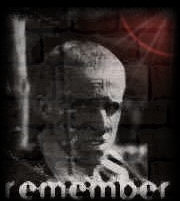




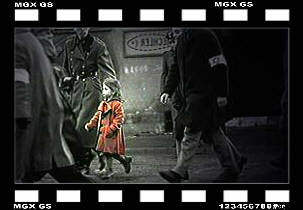
Perhaps the most moving image in Steven Spielberg's epic Schindler's List is the little girl in the red coat, one of only four color images in the three-hour black and white film. Our attention is drawn to the little blonde tot, overlooked by the Nazi troops, who wanders alone amid the horror and panic. She is wearing a red coat which draws the viewer to her even when she is but one of a hundred people in a wide shot.
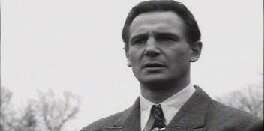
In his book Schindler's Ark Thomas Keneally tells about Oscar Schindler, on horseback, as he views the liquidation of the Cracow ghetto from atop an adjacent hill. The child in red compells Schindler's attention, and his mistress Ingrid comments that the child must be female, because little girls get obsessed by color, especially a bright shade of red like that. In the beginning the SS guard corrects her drift and nudges her back into line. Schindler can not see why he does not bludgeon her with his rifle butt, since at the other end of Krakusa Street mercy has been cancelled.
"At last Schindler slithered from his horse, tripped, and found himself on his knees hugging the trunk of a pine tree. The urge to throw up his excellent breakfast was, he sensed, to be suppressed, for he suspected it meant that all his cunning body was doing was making room to digest the horrors of Krakusa Street.
Later in the day, after he had absorbed a ration of brandy, Oscar understood ... they permitted witnesses, such witnesses as the red toddler, because they believed all the witnesses would perish too ... "
Schindler had previously rationalized to himself that the reports of atrocities were just the isolated acts of individuals, but now realizes that if such atrocities are occuring in full view of this little girl, the Nazis must be acting with the full knowledge of their superiors, with the approval of the highest authority.


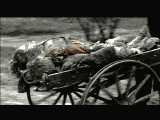
Schindler identifies with the little
girl in red, as she makes her way, aimless and alone, past the madness and chaos
in the street. A woman is machine-gunned behind her. Schindler loses sight of
the small figure as she walks behind a building, but then he glimpses her again,
walking by a file of Jews being herded down a sidewalk. During the roundup, a
Nazi soldier fires at a single-file lineup of men, killing several with one
bullet. Stricken by the nightmare below, Schindler sees the little girl in red
entering one of the empty apartment buildings. There, she climbs the stairs and
crawls under a bed for cover in a ransacked room.
An individual victim, lost. Schindler´s soul is touched by the child, he feels her pain, cries for her. The plight of the one little girl in red touches him in a way the shear numbers make unreal, it is easy to get lost in numbers. He transforms the faceless mass around him into one real palpable human being. This one child is a symbol of all the 6.000.000 victims, exposed to ruthless slaughter. Each was an individual, who had dreams, who had a life, who had a family ..
|
|
|
|
It was at that moment that Oscar
Schindler vowed that he would do everything within his power to destroy the Nazi
Regime.
While the girl is strolling unscathed while murder and brutality happen all around her, we see other stories forming or ending, but even in a telephoto view the viewer cannot take his eyes off the little red-tinted girl. She is the purity, the innocence, walking unnoticed through the Nazis, and witnessing their every crime. But the Nazis don't worry - at the end there will be no witnesses ..
We do not know what has happened to her until much later. The Nazis are ordered to dig up all the Jewish corpses they have buried to incinerate the evidence of the slaughter of the Cracow ghetto. As the decomposing corpses are trundled in wagons to the fires Oscar Schindler catch a glimpse of a red-tinted rag of a corpse.
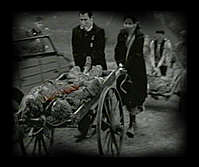
The use of color to follow the little girl in her red coat has by now achieved the stature of legendary. However, most people do not know that this image is based upon a true story, told at the trial of Adolf Eichmann, one of the most feared and hated Nazi leaders of World War II, responsible for the deaths of millions of Jews.
In the PBS documentary, The Trial of Adolf Eichmann, this image loses none of its impact when the actual story is told by Assistant Prosecutor, later Supreme Court Judge, Gavriel Bach in an interview which appears in the program. When asked if there was any moment in the trial that affected him more than any other, this is the moment he describes.
Auschwitz Bergen-Belsen Belzec Sobibor Treblinka
Bach was questioning Dr. Martin Földi,
a survivor of Auschwitz, about the selection process at the train station in the
shadows of the infamous "Arbeit Macht Frei" sign at Auschwitz. Földi described how
he and a son went to the right while a daughter and his wife went to the left.
His little daughter wore the red coat. When an SS officer sent the son to join
the mother and daughter, Földi describes his panic. How would the boy, only
twelve, find them among the thousands of people there? But then he realized the
red coat would be like a beacon for the boy to join his mother and sister.
He then ends his testimony with the chilling phrase, "I never saw them again"
While telling the story, thirty-five years after the incident, Judge Bach wells up with emotion. As Dr. Földi recounted the incident, Bach became frozen and unable to continue. All he could do was think about his own daughter who he had by chance just bought a red coat.
He then adds that to this day he can be at the theater or a restaurant and he will feel his heart beating faster when he sees a little girl in a red coat.
Aaron
Schwartz, a Polish Jew who miraculously survived the KZ camp Plaszow and the
Holocaust, later recalled the slaughter of the Cracow ghetto in
Holocaust Testimonies, edited by Joseph J. Preil, and he described the
terrible fate of a blond little girl:
"When
I came to Plaszow the first day, they put me in a group where we were digging a
huge grave .. they brought in trucks, with children, from infant to twelve years
old. They were all killed .. when the children were brought in, they were shot,
right in that grave ..
One group was bringing, with a wheelbarrow, some chlorine powder and putting on,
because there was such a tremendous amount of bodies in those graves ..
A
little girl, a beautiful blond girl, sat down in the grave, dressed in an Eskimo
white fur coat, was all bloody, and asked for a little bit of water .. this
child swallowed so much blood, because it was shot in the neck. And then it
started to vomit so terribly. And then it lay down and it says, "Mother,
turn me around, turn me around." ..
This child did not know what happened to it. It was shot, it was half-dead after
it was shot. And this child sat down in the grave, among all the corpses, and
asked for water .. it was still alive. There was no mother, just children
brought from the Cracow ghetto.
So this little girl lay down, and asked to be turned around. What happened to it?
I do not know. It was probably covered alive, with chlorine .. I am sure,
because they did not give another shot to that girl .."
Over one million children under
the age of sixteen died in the Holocaust
- she was one
of them ...
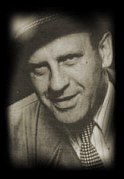
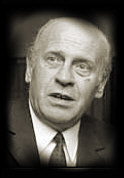
sources:
Thomas
Keneally - Schindler's Ark
Holocaust Testimonies, edited by Joseph J. Preil. The Holocaust Resource
Foundation for Kean University 2001. Rutgers University Press.
www.auschwitz.dk www.oskarschindler.com www.emilieschindler.com www.shoah.dk
© 2015-2017
Louis Bülow Privacy
All Rights Reserved.